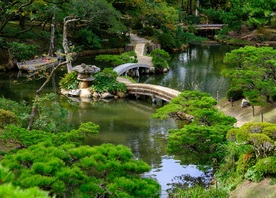Few beyond the borders of Japan have likely heard of pachinko, but this complex game is big business in Japan. A form of gambling that at first glance looks a lot like pinball, pachinko is an immensely popular game that can take a lifetime to master. While many visitors to Japan are keen to explore the country’s love of arcades and games, it’s a little harder to know where to start with pachinko. So to help you find bearings with this complex game, we’ve put together all the basic things you need to know about pachinko to get you started.
Table of contents:
What is Pachinko?
So what exactly is pachinko? The easiest way to describe the game is that it's a cross-between pinball and slot machines, that relies on both skill and luck to win. Players launch balls around a special pachinko machine trying to win more and more balls, which they can then either keep playing with or hand in for their winnings. It’s a form of gambling that’s long been exclusive to Japan and only just started to see interest abroad in recent years.
The name pachinko actually doesn’t mean anything, and is instead an onomatopoeia based on the sound pacha or pachin that the game makes. Pachinko machines first started out as a children’s game from the US in the 20s called the "Corinthian Bagatelle".
Soon enough though it became popular among the adult community of Nagoya and following the war, the first commercial pachinko parlor in Nagoya was opened in 1948. Since then, pachinko has grown enormously to become a massive industry in Japan, one with plenty of quirks that are fascinating to unpick.
How Do You Play Pachinko?

To play pachinko, patrons start by purchasing a small bucket of balls that look like metal ball bearings. These balls typically go for 4 yen each but are usually bought in bulk in the hundred yen range.
Once at a machine, players will launch the balls into the machine in the hopes of directing them into certain pockets of the machine that will trigger a jackpot. Win a jackpot and a flood of balls will fall into your tray, giving you more opportunities to play and win.
The skill in pachinko comes from knowing just how hard to launch the ball in the machine to find the path to these pockets. But then there’s the element of chance as well, as each ball in the right pocket triggers a slot machine which determines how many additional balls you’ll win.
Ultimately, tourists may learn the basics of pachinko, but it takes time and a lot of playing to truly master its precision and understand all its complexities. Things only get more difficult when you factor in the different modes and mini-games that can come up in modern digital machines.
How Do Pachinko Machines Work?
To understand how pachinko machines work, it’s important to establish that pachinko machines have evolved quite a lot over the years.
Originally, pachinko machines were wholly mechanical devices and quite similar to old school pinball machines. To ensure that the machines continued to provide a challenge, parlors would regularly reposition the pins inside the machine so that players would have to learn and master their new configurations. These original mechanical machines are still able to be found in pachinko parlors and often the best for new players to try due to their more straightforward nature.
However, nowadays they are mostly full of digital pachinko machines that have an LCD display that handles many of the jackpot aspects of the game. These newer machines have introduced new concepts to pachinko, such as kakuhen, jitan and koatari that relate to the probability and jackpot systems of digital pachinko machines, as well as minigames and different modes.
One last type of pachinko machine that’s worth mentioning are pachislo machines. These machines are much more like slot machines, using tokens rather than balls and are operated using a small lever and buttons. There is still some skill involved with pachislo, as it’s the timing of the buttons that determine whether you win or not.
Why is Pachinko Popular in Japan?
Just as it’s difficult to describe exactly what pachinko is, it’s just as hard to establish the specific reasons why it’s so popular in Japan. But popular it is, with the pachinko industry said to generate more revenue than the gambling markets of Las Vegas, Macau and Singapore combined back in 2015.
The reality is that there are quite a few reasons why it has remained such a successful industry in Japan over the last 60 or so years. One reason surely is that it’s Japan’s one legal outlet for gambling, allowing players to try their luck and win money playing pachinko. In fact, during Japan’s long economic downturn many turned to pachinko in a last ditch effort to make ends meet.
But pachinko also ties in to the nation’s love affair with gaming, with modern pachinko machines edging ever closer in style to mainstream arcade games. And with skill the major element that separates pachinko from slot machines, it’s easy to understand the challenge of trying to master the game and different machines.
There are even digital pachinko machines themed around popular media franchises such as Resident Evil, Devil May Cry and Tekken, further blurring the line between gambling and gaming.
Is Pachinko Legal in Japan?

Given that gambling is in fact illegal in Japan, it’s quite curious that pachinko is the country’s rare exception to the rule. Pachinko is legal in Japan thanks to an interesting loophole in the law that has enabled this popular pastime to endure despite its many gambling elements.
The loophole relates to how players receive their winnings, as by law players can not exchange their balls for money directly at the parlor or remove the balls from the premises. Instead, there are different systems that allow players to indirectly exchange their balls for something of value.
A standard setup is for players to receive a ticket that they must then take to a separate vendor, often very nearby, where they can exchange the ticket for their money. These separate vendors are often closely aligned with the parlor and will then sell said tickets back to the parlor to complete the complex transaction.
Other venues offer players special prize items that they can exchange their balls for, ranging from fun novelties to grocery vouchers, practical household items and even occasionally alcohol. It is these technicalities that allow the gambling of pachinko to continue despite the law.
Playing Pachinko in Japan
If you’re curious about trying pachinko for yourself while visiting Japan you should have no trouble finding somewhere to play. Pachinko parlors where you’ll find machines are found right across the country, often close to major train stations and decorated with garish, flashing neon lights.
Just know that stepping inside a pachinko parlor can be quite a shock to the senses. The noise of machines inside is sure to give your system a jolt, while the smell of stale smoke can be just as overpowering. Parlors are also not a place for much socialising or conversation, so don’t expect to find much assistance from fellow patrons when you wander in.
A nice alternative for foreigners to play pachinko and test it out in a gentler environment is to head to a video arcade instead. Many around Japan often have their own pachino machines and their fun and relaxed surroundings will make it easier to get the hang of how it all works.
Heading to Japan and keen to try your luck at Pachinko? Make sure you get your Japan Rail Pass early to make your travels that much easier.




